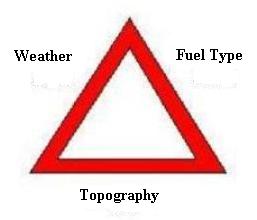Wildland Fire Basics
Wildland Fire Triangle
In addition to the general fire triangle, wildland fires have three additional
elements to consider which form the wildland fire triangle. These elements are
weather, fuel type, and topography which are shown in Figure 2 below.

Figure 2: Fire Triangle
Weather
- The most dangerous of the three sides of the triangle is
the weather variable because it is unpredictable and subject to change in a
moments notice; whereas topography and fuels are a known elements that can
be considered and dealt with. With fuels and topography held constant, a wildland
fire can behave drastically differently given certain weather conditions.
Weather forecasts and conditions must be constantly monitored throughout a wildland
fire campaign. Wind, relative humidity, and
temperature are the most important weather variables that determine fire behavior
(Teie 150).
Topography
- Topography deals with the geography of the area.
Hills, mountains, valleys, rivers, and many other physical characteristics of the
land area are evaluated in order to determine the best method of attack to be
used in a given region. The most important topograpic features to be considered are the steepness
of the slope as well as the shape of the terrain (Teie 151).
Fuels
- Finally the fuel sources available in the area are taken into
consideration. Is the area woody? Grasslands? New growth? or Old Growth? Fuels
will affect the rate of spread of a wildland fire as well as the intensity of
the fire (Coleman, et al. 561). The available fuel sources will also play a vital role in determining
what method of attack is best suited for the situation. The most important factors
when evaluating the fuel sources in the area are the moisture content and temperature
of the fuels available (Teie 151).
Home|
Fire Basics|
Wildland Basics|
Fire Behavior|
Methods of Attack|
References
Heather Christian
fnhlc@uaf.edu
Phys 212x-SF05-General Physics II
Last update 03/17/2005

